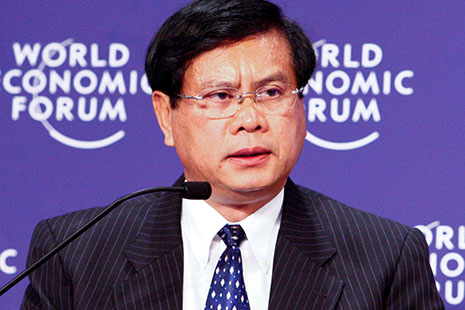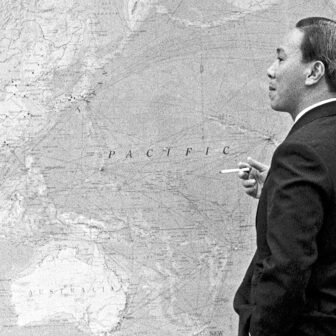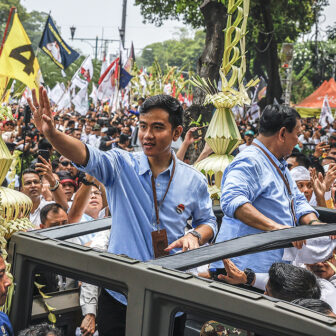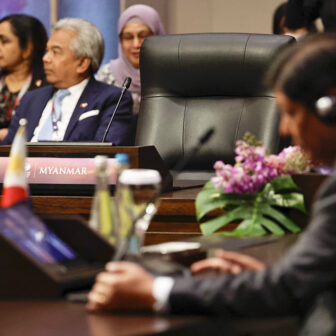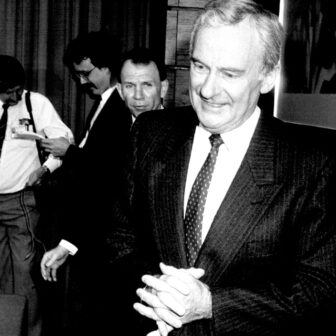THE surprise resignation of the Lao prime minister, Bouasone Bouphavanh, two days before Christmas brought about a transfer of power in Laos every bit as efficiently as the replacement of Kevin Rudd by Julia Gillard – but with none of the accompanying press speculation and commentary.
The Lao News Agency, KPL, simply reported that Bouasone had resigned in a statement to the National Assembly, which then unanimously endorsed the assembly president, Thongsing Thammavong, as his successor. The English-language Vientiane Times added that Bouasone had resigned because of “family problems,” but provided no other information. Thongsing, for his part, said only that his appointment would improve “implementation of the state’s roles and duties,” thereby ensuring continuing “political stability and basic social security.”
The mention of “family problems” was a reference to Bouasone’s recent divorce and growing resentment that his mistress had used her position to enrich herself and her family. The fact that no previous Lao leader has been forced to resign for such peccadilloes has generated alternative explanations – that Bouasone had failed to assert control over his cabinet, for example, or that he had allowed the budget deficit to blow out, or that he had failed to act promptly to deal with the “security problems” during last year’s celebrations of the 450th anniversary of the founding of the national capital, Vientiane. Some optimists even suggested that pressure for a change of leadership had come from the “democratically elected” National Assembly, which wanted more competent government.
None of these suggestions is convincing. Revenue has never been sufficient to cover more than recurrent expenditure in Laos, which has long relied on foreign aid to fund development projects. And to suggest that the National Assembly brought pressure to bear disregards the fact that all but two deputies are members of the ruling Lao People’s Revolutionary Party, or LPRP. Power within the party resides with the Central Committee, and specifically with the eleven top-ranking members who constitute the Politburo. So one thing is certain: Bouasone was replaced because powerful figures in the party hierarchy wanted him out.
But why? One clue lies in the timing of his ousting, three or four months before the Ninth Party Congress (for which no firm date has yet been announced). The five-yearly congresses do two things: they determine membership of the all-powerful Politiburo and Central Committee, and they endorse the next five-year plan. But position trumps policy. Intense politicking to decide the membership of the Politburo and rankings in the Central Committee goes on for months within the highly secretive LPRP; at the congress itself, these decisions are simply rubber-stamped. There is little doubt that Bouasone’s replacement is part of the jockeying for position prior to the congress.
Bouasone owed his own elevation at the previous congress in 2006 to support from outgoing party and state president Khamtai Siphandone. Bouasone was Khamtai’s long-time personal secretary, and rose in the party on his patron’s coattails. Both men are southerners, and Khamtai wanted his man in a position of power to protect his fiefdom in southern Laos. This Bouasone did, but once in power he also needed to develop his own patronage network of support within the party. Had he been able to do so it is unlikely he would have lost his job.
Who wanted Bouasone out? Given the inscrutability of Lao politics, this is more difficult to determine. The current party and state president is Choummaly Sayasone, a former general and close comrade of Khamtai, who is also a southerner. Choummaly may have agreed to get rid of Bouasone as the price for retaining his position at the Ninth Congress. Two other generals in their eighties – including Samane Vignakhet, who ranks number two in the Politburo – are expected to step down. The third-ranking member, Thongsing, is a northerner and a one-time mayor of Vientiane who has built a powerful support base within the party: for years he headed the committee responsible for managing internal party affairs. He may well have resented the appointment of Bouasone, whom he outranks, as prime minister.
Thongsing’s appointment is likely to have had the support of state vice-president Boungnang Vorachit, a former prime minister and another one-time mayor of Vientiane, who was closely associated, like Thongsing, with the veteran revolutionary Nouhak Phoumsavan. Support may also have come from the minister of foreign affairs, Thongloun Sisoulith, a northerner who was also passed over as prime minister in 2006.
Personal antagonism and resentment within the upper echelons of the leadership usually get put aside for the good of the party. Competition between regional interests carries more weight, and it may be that Bouasone’s replacement is indicative of a shift in the balance of advantage between southern and northern interests. Such competition becomes more intense before party congresses for the simple reason that who gets into the Politburo, or jumps up in the rankings in the Central Committee, influences opportunities to build political patronage and gain a greater share of the spoils of office.
Foreign observers frequently cite another factor at play in Lao politics: the competition between China and Vietnam for political influence. The LPRP depends on support from the communist parties of its far more powerful neighbours, both of which have significant economic interests in Laos. Traditionally, Vietnam has enjoyed closer party-to-party ties, but China has greater economic power and has invested heavily in infrastructure in Laos; the investments are part of Beijing’s involvement in the Greater Mekong Subregion project, which will link southern China with the states of mainland Southeast Asia (including roads and a proposed rail link between China and Thailand to run through Laos).
The Lao political leadership has been proficient in balancing friendly relationships with both China and Vietnam, and there is broad agreement that this balance must be maintained – just as there is general agreement that Laos should also maintain friendly relations with other ASEAN states, notably Thailand; with Japan, still the principal donor of foreign aid; and with the West. For a while the former foreign minister Somsavat Lengsavad, himself an ethnic Chinese from Luang Phrabang, was suspected of favouring Beijing over Hanoi. Somsavat, a northerner, may well have thrown his support behind Thongsing, but we should be wary of seeing this as reflecting Chinese involvement.
In the intense jockeying for places in the Politburo, Bouasone might not even retain his place. Among those ambitious for entry are three members of the Central Committee who jumped several places in the rankings at the 2006 Congress, among them the current security minister. They too may have reasons to back Thongsing, as may the woman who stepped into his shoes as president of the National Assembly, Pany Yathotu, the only Hmong in the Politburo.
BUT one issue more than any other is likely to have solidified opposition to Bouasone, and that is the threat of reduced opportunities for gain, both personal and for the extended family and patronage networks of powerful party leaders. Bouasone had promised to crack down on these “negative phenomena,” as he euphemistically put it. He maintained the embargo on exporting whole logs from Laos’s disappearing forests, though the military took little notice. And he followed this up with an embargo on land concessions, and another on new mining concessions.
Bouasone was under intense pressure from foreign aid donors and financial institutions to announce these embargoes. Though there was little rigorous enforcement, they did limit lucrative sources of graft for senior party members, threatening the interests of all those determined to exploit their positions in the way others had done before them. Significantly, Thongsing has said nothing about limiting corruption, though he has vowed to improve government efficiency in order “to ensure state activities are timely, transparent, united and harmonious” – whatever that might mean.
Corruption is the ogre in the woodpile of Lao politics. It extends throughout the bureaucracy and the police and security forces. Much of this is at a petty level, but much is harmful – and not just to the reputation of the party. Environmental laws are flouted as officials are paid to turn a blind eye to the smuggling of timber (mostly to Vietnam by the military) and endangered wildlife (mostly to China). Taxes and customs dues are “negotiated” – reduced in return for a consideration paid to officials – to the detriment of state revenues. In Transparency International’s corruption index for 2010, Laos came in at number 154 out of 178 countries.
The pervasiveness of corruption is due in large part to the example set by political leaders. Members of the Politburo and their families have become excessively rich. They have built vast villas, drive luxury cars, and hold lavish parties. Marriages between children of the political elite are occasions for the display of wealth, with political favours paid off in the form of envelopes stuffed with cash. Children of the elite are immune to the law in a country where legal disputes are often decided on the basis of who pays the judge the biggest bribe.
Businesses pay bribes for government contracts and for political protection (obtained by placing prominent party members on their boards). Foreign-owned businesses pay off party officials and tax assessors. Chinese mining companies reportedly pay to avoid undertaking environmental impact assessments. Probably the worst corruption, however, occurs over land. Large areas in Laos have been given over to foreign, mainly Chinese, companies on long leases for plantation forestry and agriculture. As land outside the urban areas legally belongs to the state, even where it has traditionally been used by villagers for collection of forest products or slash-and-burn farming, local and central government officials can and do accept substantial payments to sign off on leases and forcibly remove anyone who objects.
In a country where expenditure on social services is abysmally low, corruption chronically depletes revenue. Yet the government proclaims its intention to lift the country out of the UN’s least-developed category by 2020. Tourism is a major industry, but the principal resource industries capable of topping up government coffers are mining and hydropower. Mines pay dues and royalties, and hydropower is sold to neighbouring countries. The huge US$1.45 billion Nam Theun II hydro dam in central Laos, officially inaugurated in December, generates 1070 megawatts of electricity, over 90 per cent of which will be sold to Thailand, netting the government around US$80 million a year. Several other dams are under construction on tributaries of the Mekong, while others – including on the main channel of the upper Mekong – are on the drawing board. Warnings about possible environmental damage go unheeded.
Given the “leakage” that occurs through corruption in every government program and foreign aid project, from building a school to maintaining an irrigation system, it remains to be seen whether income from resource industries will be sufficient to cover the increased expenditure required to meet the government’s development plans. Laos does have an anti-corruption law, but unlike China and Vietnam, no senior official has ever been indicted. Nor is this likely to change, Laos’s patrimonial political culture needs to be constantly oiled through the disbursement of wealth and favours, and corruption provides the means. Changing prime ministers in the lead-up to the Ninth Party Congress is not going to change that. •
